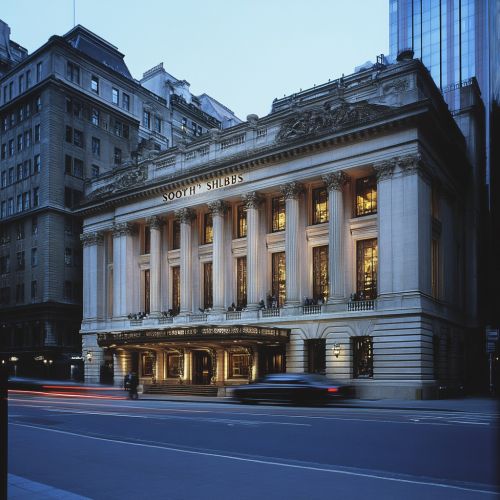Sotheby's: Difference between revisions
(Created page with "== History of Sotheby's == Sotheby's is one of the world's most renowned auction houses, with a history that dates back to the 18th century. Founded in 1744 by Samuel Baker, Sotheby's has evolved from a small book auction business into a global entity dealing in fine art, jewelry, real estate, and collectibles. The first auction conducted by Baker was the sale of "several hundred scarce and valuable books" from the library of Sir John Stanley, which marked the begin...") |
No edit summary |
||
| Line 43: | Line 43: | ||
As the art and auction markets continue to evolve, Sotheby's remains a key player, shaping trends and setting standards for the industry. The auction house's rich history and global influence ensure its continued relevance and impact in the years to come. | As the art and auction markets continue to evolve, Sotheby's remains a key player, shaping trends and setting standards for the industry. The auction house's rich history and global influence ensure its continued relevance and impact in the years to come. | ||
[[Image:Detail-99427.jpg|thumb|center|Exterior view of Sotheby's auction house building with a classic architectural design.|class=only_on_mobile]] | |||
[[Image:Detail-99428.jpg|thumb|center|Exterior view of Sotheby's auction house building with a classic architectural design.|class=only_on_desktop]] | |||
== See Also == | == See Also == | ||
Latest revision as of 00:30, 30 October 2024
History of Sotheby's
Sotheby's is one of the world's most renowned auction houses, with a history that dates back to the 18th century. Founded in 1744 by Samuel Baker, Sotheby's has evolved from a small book auction business into a global entity dealing in fine art, jewelry, real estate, and collectibles. The first auction conducted by Baker was the sale of "several hundred scarce and valuable books" from the library of Sir John Stanley, which marked the beginning of Sotheby's long-standing tradition in the auction industry.
Over the centuries, Sotheby's expanded its operations beyond books, entering the art market in the 19th century. This expansion was marked by the acquisition of the art auction house Wilkinson & Hodge in 1864. The 20th century saw further growth, with Sotheby's establishing offices in major cities worldwide, including New York, Paris, and Hong Kong. The company went public in 1977, further solidifying its position as a leader in the auction world.
Auction Process and Operations
Sotheby's operates through a complex auction process that involves several stages, from consignment to the final sale. The process begins with the consignment of items, where potential sellers submit their valuables for evaluation. Sotheby's experts assess the items' authenticity, provenance, and market value, providing sellers with an estimate of the expected auction price.
Once items are consigned, they are cataloged and prepared for auction. Sotheby's produces detailed catalogs that include photographs, descriptions, and historical context for each item. These catalogs are distributed to potential buyers and are also available online, allowing for global access to the auction inventory.
The auction itself can be conducted in various formats, including live auctions, online auctions, and private sales. Live auctions are traditional events held in Sotheby's auction rooms, where bidders participate in person, by phone, or via the internet. Online auctions have gained popularity, offering a more accessible platform for global participation. Private sales provide an alternative to the auction format, allowing for confidential transactions between sellers and buyers.
Notable Auctions and Sales
Sotheby's has been involved in numerous high-profile auctions that have set records in the art and collectibles market. One of the most notable sales was the auction of Edvard Munch's "The Scream" in 2012, which fetched $119.9 million, making it one of the most expensive artworks ever sold at auction. Another significant sale was the auction of the "Pink Star" diamond in 2017, which sold for $71.2 million, setting a record for the highest price ever paid for a gemstone at auction.
The auction house has also been involved in the sale of iconic historical artifacts, such as the Magna Carta, which sold for $21.3 million in 2007, and the personal belongings of famous figures like Marilyn Monroe and Albert Einstein. These sales highlight Sotheby's ability to attract rare and valuable items, drawing interest from collectors and investors worldwide.
Global Presence and Influence
Sotheby's operates in over 40 countries, with major offices and galleries in cities such as London, New York, Paris, and Hong Kong. This global presence allows Sotheby's to tap into diverse markets and cater to a wide range of clients, from seasoned collectors to first-time buyers. The auction house's influence extends beyond the art market, impacting cultural and economic trends worldwide.
Sotheby's has also embraced technological advancements, incorporating digital platforms and tools to enhance the auction experience. The introduction of online bidding and virtual reality previews has made auctions more accessible and engaging for a global audience. Additionally, Sotheby's has invested in data analytics and artificial intelligence to provide insights into market trends and buyer behavior, further solidifying its position as a leader in the auction industry.
Art and Cultural Impact
Sotheby's plays a significant role in the art world, influencing trends and shaping the market for contemporary and historical artworks. The auction house's sales often set benchmarks for the value of art, impacting artists, galleries, and collectors. Sotheby's also collaborates with museums and cultural institutions, lending expertise and support for exhibitions and educational programs.
The auction house's impact extends to the preservation and promotion of cultural heritage. Sotheby's has been involved in the sale of important cultural artifacts, ensuring their continued appreciation and study. The auction house's commitment to cultural preservation is reflected in its efforts to return looted or stolen artifacts to their rightful owners, adhering to ethical standards and international agreements.
Challenges and Controversies
Despite its success, Sotheby's has faced challenges and controversies throughout its history. The auction house has been involved in legal disputes over the authenticity and provenance of certain items, highlighting the complexities of the art market. Sotheby's has also faced criticism for its role in the commercialization of art, with some arguing that the auction process prioritizes profit over artistic value.
In recent years, Sotheby's has addressed these challenges by implementing stricter due diligence processes and enhancing transparency in its operations. The auction house has also embraced sustainability initiatives, reducing its environmental impact and promoting ethical practices within the industry.
Future Prospects
Sotheby's continues to evolve, adapting to changes in the market and embracing new opportunities. The auction house's focus on innovation and technology positions it well for future growth, with digital platforms playing an increasingly important role in its operations. Sotheby's commitment to diversity and inclusion is also evident in its efforts to expand its client base and support underrepresented artists and communities.
As the art and auction markets continue to evolve, Sotheby's remains a key player, shaping trends and setting standards for the industry. The auction house's rich history and global influence ensure its continued relevance and impact in the years to come.


